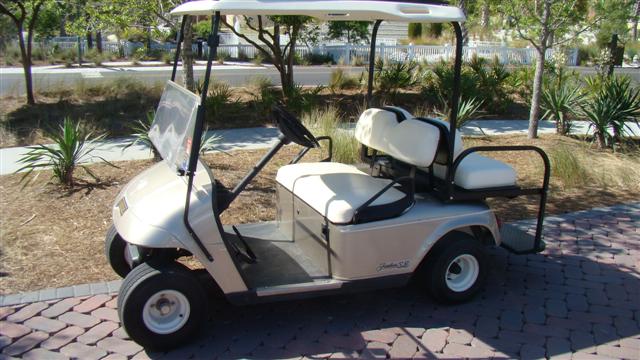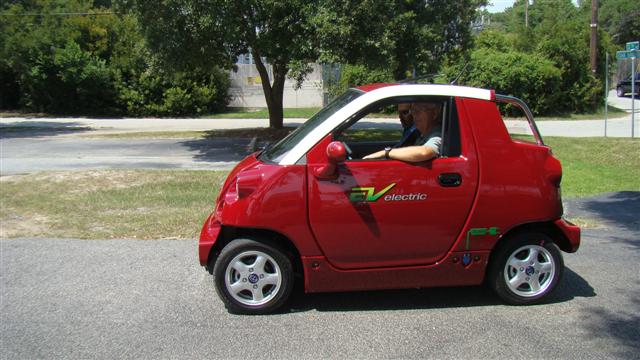Golf Carts & Low Speed Vehicles
 Golf Carts
Golf Carts
In accordance with South Carolina state law section 56-2-105, golf cart owners who have a valid driver's license, a permit from the South Carolina Department of Motor Vehicles and proof of insurance may operate the golf cart on a secondary highway or street within four miles of his or her residence or place of business during daylight hours only. Additionally, golf carts may cross a primary highway or street (such as Palm Boulevard from 41st Avenue to Breach Inlet) but cannot travel along primary highways or streets. Golf carts may not be parked on beach access paths unless signs exist indicating that golf cart parking is permissible. The law prohibits golf carts from being upgraded by adding equipment to convert the cart to a Low Speed Vehicle (LSV). A golf cart can not be legally operated in the Isle of Palms after dark.
Golf cart permits are available at any SCDMV branch office. The permit allows a licensed driver to operate a golf cart during daylight hours on a secondary highway or street within four miles of his residence or place of business. Golf carts can only be operated on roads with posted speeds of 35 mph or less.
To obtain a golf cart permit, you must:
- Complete Form GC-2, Golf Cart Permit Registration
- Provide proof of insurance for the golf cart
- Provide a valid driver license number for the operator
- Submit a fee of $5.00
A golf cart permit must be replaced with a new permit every five years or at the time the permit holder changes his or her address.
Golf Cart Parking
Isle of Palms residents may apply for a Residential Parking Permit for their golf carts which will allow them to park in the public rights-of-way in the Residential Parking District from 9:00 a.m. to 6:00 p.m. To apply for the permit, residents must provide proof of residency and the golf cart registration.
Designated Golf Cart parking is available on 9th Ocean Boulevard, 28th and 31st Avenues on Palm Boulevard.
Low Speed Vehicles

Low Speed Vehicle (LSV): In accordance with South Carolina code of law 56-2-100, a Low Speed Vehicle is a four-wheeled vehicle whose speed attainable in one mile is more than twenty miles per hour (20 mph) and not more than twenty-five miles per hour (25 mph).
A low speed vehicle may be operated on a highway or street for which the posted speed limit is 35 mph or less. LSVs cannot be operated on the IOP Connector as it has a speed limit of 45 mph. A low speed vehicle may cross a highway at an intersection where the highway has a posted speed limit of more than 35 mph. A low speed vehicle must meet the requirements of Federal Motor Vehicle Safety Standard 500 (Part 49 Section 571.500 of the Code of Federal Regulations) at all times when operated on any highway. A low speed vehicle may be operated after dark.
Like a golf cart, an LSV can only be operated by a person with a valid driver's license, a permit from the Department of Motor Vehicles and proof of insurance. The state will not title or register homemade Low Speed Vehicles or retrofitted golf carts. An LSV is factory equipped with windshield wipers, rear-view and side-view mirrors, speedometer, turn signals, horn, DOT headlights, taillights, and seatbelts.
Note: Do not operate a Golf Cart or LSV while under the influence of drugs or alcohol. You can still be charged with DUI while operating these vehicles. Likewise, you can also be charged for having an open container, just as you would in your car.
Safety Guidelines
Passenger Safety
- Have no more than one passenger per seat.
- Do not overload the cart with passengers or cargo.
- Keep all parts of the body in the cart at all times.
- Do not let anyone stand when the cart is in motion.
- Make sure all cargo is secured to the cart while in motion.
While In Use
- Obey traffic laws when on the road.
- Use hand signals when turning or stopping.
- Avoid distracted driving (cell phone use, drinking, eating).
- Slow down when approaching and making turns, and driving on slopes.
- Look behind before operating in reverse.
Fire Safety
- Follow the manufacturer’s instructions for charging and maintaining your cart.
- Never charge carts overnight.
- Refuel the cart in a well-vented area and only when the engine has cooled.
- Never use a damaged charging or extension cord for charging the golf cart.